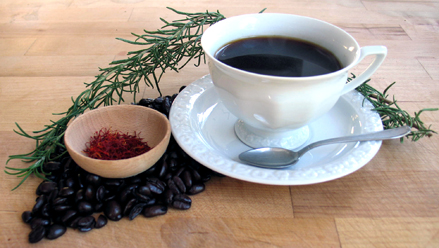In the Penn family papers (Collection 485), Volume NV-006, there are two recipe books. Institutional lore says that they were written by each of William Penn's wives and as they are in obviously different handwritings, this is possible. However, at the top of one of the pages there is a note, "My Mother's receipts for Cookerys.... [signed] William Penn." Suffice to say, the manuscripts belonged to the Penn family.
One of the manuscripts is easily legible and concerns many remedies for eye afflictions. The other manuscript details a wide variety of recipes including Almon Cakes, Snuff, and Marmalade of Oringes. I have not spent much time with either of the books, as the first set of recipes (those for eye care), can make the reader queasy. The handwriting in the second set of recipes is so difficult to read that it took me the better part of a day to puzzle out the recipe I wanted: Too Make Coffee. When first looking at the recipe, I read Too Make Coffoo as the construction of the “e” is backwards (see below). But working my way through the strange letter construction and extra flourishes of this handwriting was worth it for a chance to taste a 300-year-old coffee recipe.

Too Make Coffee:
Take water and boyle it but very littell then have ready your coffee pott that hold a pint a quart with an oz of the powder in it and brew it with a quart of water as you doo burnt wine then lett it stand in the Coffee pott with 3 or 4 springs of Rosemary and 20 grains of saffron desolined (my underline) it must stand so as to bee scalding hott butt not boyle you may drink it in 1/2 an hour butt if it stand an hour or too its better.
There is only one word I could not work out, desolined. One of our readers speculates it meant that the coffee needs to be mixed till the saffron is dissolved, or "desolved."
If you would like to try this recipe yourself, here’s what I did:
- 4C water
- 4T ground coffee of your choice
- 3 – 4 twigs of fresh rosemary approximately 4 inches long
- 2 good pinches of saffron (or you can count out 20 grains, tweezers might help with this)
Put the water and coffee into a pot and bring them to a boil. When making coffee this way I let the coffee boil up, remove the pot from the heat until it settles, put the pot back on the heat and repeat this process twice more. Turn heat to low, add the rosemary and saffron, and allow it to simmer for an hour. Strain the liquid before serving.

I will be honest about my reaction; the first sip was a bit of a shock. I found the flavor to be very unusual. This is a recipe for the adventurous palate to be sure! However, after a few sips the flavor mellows. With milk and sugar I ended up drinking the whole pot and decided it was delicious!
As I went back to the original manuscript for this blog post, I realized that the coffee recipe is not with other foods or drinks. It is in the middle of recipes for medical ailments and sundries including "receipt to Cure the biting of a mad dogg if taken within 9 days." Many old family recipe books did not have any organization. New recipes were added at the end as they came along. But it seems there is some kind of organization to this manuscript. Is it possible that this recipe was intended, not as an enjoyable drink, but as medicine? The caffeine would have given a remarkable energy boost, and in the 17th century, coffee was still a relatively new drink in England. According to Reay Tannahill in her book Food in History, the first coffee house in England was established in 1650. Merchants advertised it as a magical elixir to cure everything from gout to asthma. William Penn was born in 1644 and if these are indeed his mother's recipes, she would have learned them at or close to the beginning of coffee in England. Could this recipe have been an early experiment for an even better "cure"?
Either way, should you be intrigued enough to try your own pot of Mrs. Penn’s coffee, we hope you'll drink it in good health!

